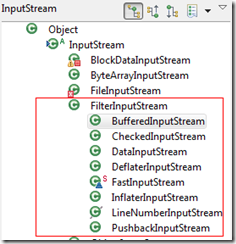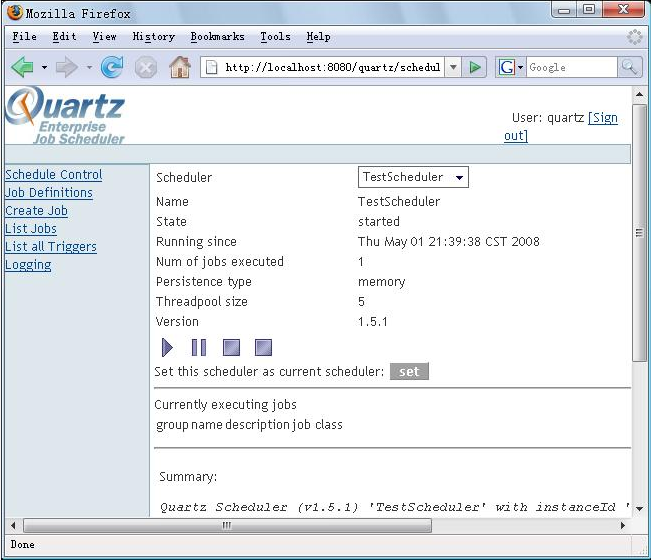java io FilterInputStream BufferedInputStream
1. FilterInputStream的结构图

/**
* A FilterInputStream contains some other input stream, which it
* uses as its basic source of data, possibly transforming the data along the
* way or providing additional functionality. The class
* FilterInputStream itself simply overrides all methods of
* InputStream with versions that pass all requests to the
* contained input stream. Subclasses of FilterInputStream may
* further override some of these methods and may also provide additional
* methods and fields.
*
* @author Jonathan Payne
* @version %I%, %G%
* @since JDK1.0
*/
public class FilterInputStream extends InputStream
FilterInputStream继承自InputStream, 可以将其他的输入流作为起数据源.
FilterInputStream只是简单的重写了InputStream里面的方法,直接看看BufferedInputStream
2. BufferedInputStream的类结构
/**
* A BufferedInputStream adds functionality to another input
* stream-namely, the ability to buffer the input and to support the
* mark and reset methods. When the
* BufferedInputStream is created, an internal buffer array is
* created. As bytes from the stream are read or skipped, the internal buffer is
* refilled as necessary from the contained input stream, many bytes at a time.
* The mark operation remembers a point in the input stream and the
* reset operation causes all the bytes read since the most recent
* mark operation to be reread before new bytes are taken from the
* contained input stream.
*
*/
public class BufferedInputStream extends FilterInputStream
BufferedInputStream为另外的输入流添加一些功能,其内部维护了一个缓冲区数组。
创建BufferedInputStream
private static int defaultBufferSize = 8192;
protected volatile byte buf[];
public BufferedInputStream(InputStream in) {
this(in, defaultBufferSize);
}
public BufferedInputStream(InputStream in, int size) {
super(in);
if (size <= 0) {
throw new IllegalArgumentException("Buffer size <= 0");
}
buf = new byte[size];
}
初始化一个byte数组, 一次性从输入流中读取指定长度的的数据放到数组中。当程序要读取字节的时候,
直接从byte数组里面读取。
3. BufferedInputStream的缓冲区
通过上面的构造函数可以看到byte数组具有缓冲区的功能, 每次读去数据都是从该缓冲区数组里面读取。
protected int count; //当前缓冲区内总共有多少有效数据
protected int pos; //表示当前读取到的位置,即byte数组的当前下标,下次读取从该位置读取
protected int markpos = -1; //标记的位置
protected int marklimit; //最多能mark的字节长度,也就是从mark位置到当前pos的最大长度
public synchronized int read() throws IOException {
if (pos >= count) {
fill();
if (pos >= count)
return -1;
}
return getBufIfOpen()[pos++] & 0xff;
}
通过read方法可以看到,当缓冲区的数据全部读完的时候, 填充缓冲区。这样读取数据都是从缓冲区里面
读取,不会从真正的数据源读取。
3.1 read()方法 返回值 getBufIfOpen()[pos++] & 0xff
我们知道当文件到达结尾的时候是以 -1 表示, 如果是字符流没有负数,返回-1是OK的。但是byte或int 本身包含 –1 这个数, 所以不能直接返回 –1 。
在java中, byte的大小是8 bits 而 int的大小是 32bits;java的二进制采用的是补码的形式
0xff是int类型,二进制为0000 0000 0000 0000 0000 0000 1111 1111
上述的与运算实际上读取的byte先被强制转换成了int,例如byte的-1(最高位表示符号位,以补码的形式表示负数为:1111 1111)
转换为int之后的二进制1111 1111 1111 1111 1111 1111 1111 1111
& 0xff之后高位去0, 最后返回的结果是0000 0000 0000 0000 0000 0000 1111 1111, 为int值为256 .
其-128~-1被转为int中128~256的正数表示。这样解决了可以用-1表示文件已经读完。
但关键是数据的值发生了变化,真正要用读取的数据时是否还能拿到原始的byte。
还拿上面那个例子来看,当读取返回一个256时,将其强制类型转换为byte,(byte)256得到byte的-1,
因为byte只有8位,当int的高位被丢弃后就只剩下1111 1111,在byte中高位的1表示符号位为负数,最终的结果即是byte的-1;
同样byte的-128(1000 0000)被转为int的128(0000 0000 0000 0000 0000 0000 1000 0000),强制类型转换后还原byte的1000 0000。
3.2 线程安全
我们知道 ++操作其实是线程不安全的, BufferedInputStream里面的public方法都是synchronized的,已保证整个缓存数组是
线程安全的, 关闭方法没有加synchronized,是为了避免过大的系统消耗。
作者:牛哥哥补充:软件开发 , Java ,




